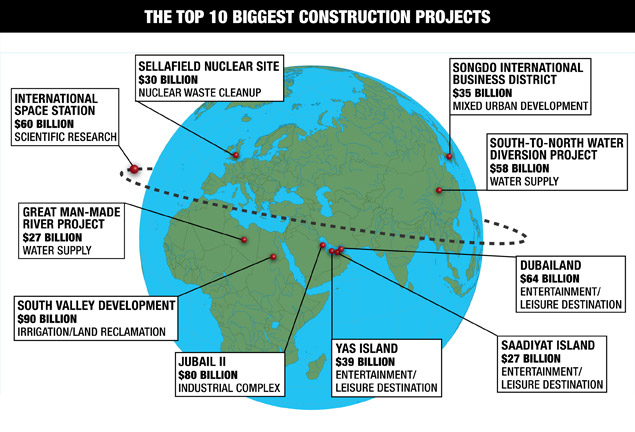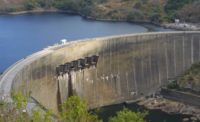To relieve the problem of population density, the Egyptian government has embarked on a vast effort to reclaim 2,300 sq miles of desert in southern Egypt.
The first major component was the world’s largest pumping station, with a capacity of 25 million cubic meters per day, completed in 2003. Located on the west bank of Lake Nasser, it pumps Nile River water into the Sheikh Zayed Canal, which is 30 meter wide at the bottom, 54 m wide at the surface, 8 m deep and 72 kilometer long. The New Naga Hammadi Dam on the Nile, completed in 2008, channels additional water.
Three major areas will be reclaimed: Toshka, East Oweinat and the Western Desert Oasis. All four branch canals carrying water from the Sheikh Zayed Canal to Toshka are completed.
By 2008, only 8,000 acres out of the 560,000 acres supplied with water in the Toshka Valley had been planted. Government-subsidized farmers were growing wheat, corn and vegetables on 7,000 of those acres. The government’s failure to provide roads, warehouses and housing to support the development at Toshka have hindered the project.
Another significant barrier to development of Toshka has been the reluctance of workers to move there permanently. Engineers, technicians, drivers and equipment operators will only work there seasonally, returning to live with their families in their towns and cities in the Nile Valley and the Delta.
The only private investor in Toshka to date is Prince Alwaleed Bin Talal of Saudi Arabia. He bought 100,000 acres of land in the Toshka Valley in 1998, through his company, Kingdom Agricultural Development Co. As of 2008, about four years after water was supplied to Toshka, only 1,000 acres of Kingdom’s land was being farmed, mostly to raise produce for export to Europe. In March 2010, Prince Alwaleed announced that he planned to sell 50% of his agricultural firm, probably to Asian investors.
In January 2010, the government announced a change in direction on the project. Previously, land had been offered to buyers on an ownership basis, but some investors had held the land as speculators, without investing funds to begin cultivating their plots. Agriculture Minister Amin Abaza said that 300,000 acres in Toshka would be offered to investors on a usufruct basis. Under this new system, investors will have three years to complete their development activities or risk losing title.
East Oweinat, an area south of Toshka, is developing more rapidly. There, 540 wells ranging from 25 to 100 m deep are supplying water. A number of private companies own 10,000- acre blocks of land, growing wheat for sale to the government’s flour mills (bread is Egypt’s staple food), as well as chickpeas, peanuts and vegetables, which are sold locally.
The Western Desert Oasis also are operating successfully, supporting several hundred thousand people engaged in farming.
Officials predict that six million people eventually will relocate from the overcrowded Nile Valley to the reclaimed land. (ENR 11/30/98 p. 61; 5/7/01 p. 20)
Location: Egypt
Estimated Cost: $90 billion
Construction Period: 1997-2017
Developer: Ministry of Water Resources and Irrigation
Click below on each box to view more about the project





Post a comment to this article
Report Abusive Comment